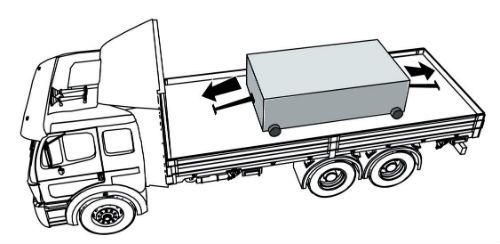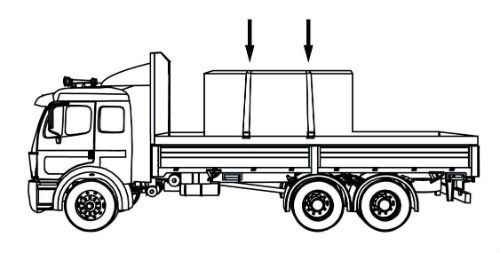CDL Practice Tests: Flatbed Cargo Securement
Choose A Section:
Go!To secure a cubic-shaped boulder, how many tiedowns are required, at minimum?
- 5
- 3
- 2
- 1
Special Circumstances: Securing a Cubic-Shaped Boulder
The securement of a cubic-shaped boulder must meet these requirements in addition to the other large boulder requirements in Section 13.

Secure each boulder individually with at least two chain tiedowns placed side-to-side across the vehicle.
Place tiedowns as closely as possible to the hardwood blocking used to support the boulder.
Which of the following is not a requirement for shortwood loaded lengthwise?
- Logs should be centered in the bunk.
- Each outside log bearing against stakes should extend at least 6 in beyond the stakes at each end.
- Must be cradled in a bunk or contained by stakes.
- Heavier logs must be stacked on top.
Requirements for shortwood loaded lengthwise
- Shortwood must be cradled in a bunk or contained by stakes.
- Logs should be centered in the bunk.
- Each outside log bearing against stakes should extend at least 0.15 m (6 in) beyond the stakes at each end.
When securing an intermodal container on a chassis, what is the maximum allowable vertical travel when secured?
- 1/2 inch
- 2 1/2 inches
- 1 inch
- 2 inches
Securing devices must restrain the container from moving more than:
- 1.27 cm (1/2 in) forward.
- 1.27 cm (1/2 in) rearward.
- 1.27 cm (1/2 in) to the right.
- 1.27 cm (1/2 in) to the left.
- 2.54 cm (1 in) vertically.
What types of freight need to be secured properly?
- Intermodal containers.
- All freight should always be properly secured while driving.
- Equipment used for vehicle operation.
- Hazardous materials.
-
Any cargo and dangerous goods/hazardous materials, including:
- All general freight.
- All equipment carried for vehicle operation.
- Intermodal containers and their contents.
- Some specific commodities have additional or different securement requirements (see later sections of this Handbook).
- Additional requirements under separate regulations may also apply for transportation of certain types of dangerous goods or hazardous materials.
Cargo
When securing rows of coils, requirements include all of the following except:
- Attach at least one tiedown over the top of each coil or side-by-side row, located near the front of the coil.
- Use blocking or friction mats to prevent forward movement.
- Attach at least one tiedown through the center of each row of coils.
- Attach at least one tiedown over the top of each coil or side-by-side row, located near the rear of the coil.
Tiedowns

Attach at least one tiedown over the top of each coil or side-by-side row, located near the front of the coil.
Attach at least one tiedown over the top of each coil or side-by-side row, located near the rear of the coil.
Use blocking or friction mats to prevent forward movement.
All of the following are requirements for transporting coils with eyes crosswise except:
- These are all requirements
- Attach one tiedown forward
- Attach one tiedown rearward
- Prevent the coil from rolling
There are three requirements for coils transported with eyes crosswise:

Prevent the coil from rolling
Attach one tiedown forward.
Attach one tiedown rearward.
The maximum distance from the rear allowed for attaching mechanisms used to secure roll-on/roll-off containers is:
- 6 1/2 feet
- It doesn't matter.
- 2 feet
- 3 feet

Attach mechanisms used to secure the rear end of a roll-on/roll-off or hook lift container no more than two meters (6.5 feet) from the rear of the container.
Which of the following is not a reason why loads should be secured?
- Make it look pretty
- Prevent loss of load
- Prevent damage to the cargo
- Avoid fines and citations
Why secure your load? To prevent:
- Loss of life
- Loss of load
- Damage to the cargo
- Damage to the vehicle
- Issuance of citations/fines to driver/carrier
- The vehicle being placed Out-of-Service.
- A crash
The Aggregate Working Load Limit should, at minimum, be:
- Determined by the shipper.
- 80% of the weight of the cargo.
- 50% of the weight of the cargo.
- 100% of the weight of the cargo.
How much should the Aggregate Working Load Limit be?
The aggregate working load limit of any securement system must be at least 50% of the weight of the cargo being secured.
Aggregate Working Load Limit is defined as:
- The maximum load that may be applied to a component of a cargo securement system during normal service, usually assigned by the manufacturer of the component.
- The summation of the working load limits or restraining capacity of all devices used to secure an article on a vehicle.
- The maximum weight of a load of rocks that a securement device can withstand.
- A combination of securing devices which form an assembly that attaches cargo to, or restrains cargo on, a vehicle or trailer, and is attached to anchor point(s).
Aggregate Working Load Limit:
The summation of the working load limits or restraining capacity of all devices used to secure an article on a vehicle.
About The Flatbed Cargo Securement CDL Manual
Studying the flatbed cargo securement CDL manual is not a requirement for getting your CDL permit or license. It is required knowledge for flatbed drivers.
Some questions you should be able to answer for flatbed cargo securement:
- What is the minimum Working Load Limit of a tiedown used to secure logs?
- What is the minimum weight of a shipment of paper rolls that would require specific securement requirements?
- When securing concrete pipe over 45 inches loaded crosswise, which direction must the tiedowns on the front half of the load run?
- What is a cab shield?
- When securing concrete pipe over 45 inches loaded crosswise, which direction must the tiedowns on the rear half of the load run?
- What is a dunnage bag?
- Who is responsible for inspecting securing devices and cargo within the first 50 miles?
- How many tiedowns are required on a stack of shortwood loaded crosswise?
- What is the minimum working load limit of each tiedown used to secure crushed or flattened vehicles?
- Define 'bolster'
- What is a hook-lift container?
- When a tiedown is attached directly to the cargo, what is the ideal angle where it attached to the vehicle?
What is a securing device?
Any device specifically manufactured to attach or secure cargo to a vehicle or trailer:
- Synthetic Webbing
- Chain
- Wire rope
- Manila rope
- Synthetic rope
- Steel strapping
- Clamps and latches
- Blocking
- Front-end structure
- Grab hooks
- Binders
- Shackles
- Winches
- Stake pockets
- D-rings
- Webbing ratchet
- Bracing
- Friction mat
What is a tiedown?
A combination of securing devices that forms an assembly that:
- Attaches cargo to, or restrains cargo on a vehicle.
- Is attached to anchor point(s).

Some tiedowns are attached to the cargo and provide direct resistance to restrain the cargo from movement.

Some tie-downs pass over or through the cargo. They create a downward force that increases the effect of friction between the cargo and the deck. This friction restrains the cargo.
 Related Cargo Securement Terms That Every Driver Should Know:
Related Cargo Securement Terms That Every Driver Should Know:
-
Tiedown:
A combination of securing devices which form an assembly that attaches cargo to, or restrains cargo on, a vehicle or trailer, and is attached to anchor point(s).
-
Contained:
Cargo is contained if it fills a sided vehicle, and every article is in contact with or sufficiently close to a wall or other articles so that it cannot shift or tip if those other articles are also unable to shift or tip.
-
Blocking:
A structure, device, or another substantial article placed against or around an article to prevent horizontal movement of the article.
How should tiedowns be attached?
Tiedowns can be used in two ways:
-
Attached to the cargo:
- Tiedowns attached to the vehicle and attached to the cargo.
- Tiedowns attached to the vehicle, pass through or aroundan article of cargo, and then are attached to the vehicle again.
-
Pass over the cargo:
- Tiedowns attached to the vehicle, passed over the cargo, and then attached to the vehicle again.
Tiedown placement:

Place the tiedown as close as possible to the spacer.
Position the tiedowns as symetrically as possible over the length of the article.

Position the tiedowns to preserve the integrity of the article.







 TT On Facebook
TT On Facebook